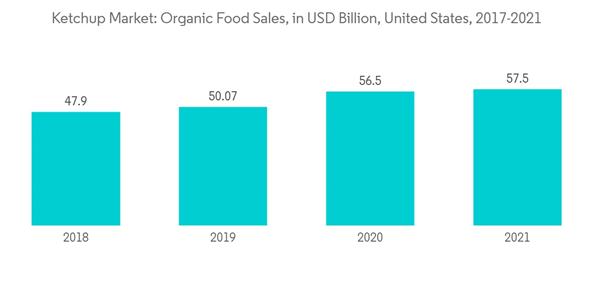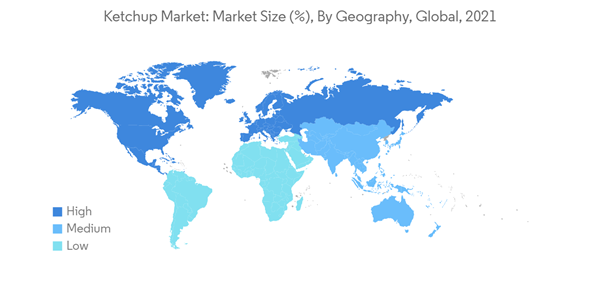Key Highlights
- The rising urbanization levels and the increasing disposable income have led many individuals to opt for on-the-go food. These food types are rapidly gaining popularity, especially among Generation Z and the millennials. Ketchup is a vital food item used across many fast-food types. Thus, these factors are likely to bring tremendous growth opportunities for the ketchup market in the coming years.
- Additionally, consumers' increasing preference for organic food, including ketchup, is driving the growth of the market. For instance, according to the Organic Trade Association, the sales of organic food amounted to approximately USD 57.5 billion in 2021 in the United States. Their growing concerns about the possible health risks of consuming artificial additives and genetically modified organisms (GMOs) have accelerated the consumption of sauces and condiments labeled as natural, organic, and non-GMO.
- Private-label ketchup brands have been performing better than well-established brands in many countries, such as the United Kingdom, France, Germany, and others. The major players are focused on providing new varieties to cater to changing consumer demands.
Ketchup Market Trends
Increasing Inclination Toward Organic Ketchup
- The growing demand for organic ketchup is one of the significant trends that is gaining market traction. The rise in health-conscious consumers due to their growing preference for organic products for their natural and healthy ingredients further fuels the market growth.
- Organic ketchup contains natural ingredients like salt, sweeteners, vinegar, and other organic flavors and spices. It also contains organic sugar instead of high fructose corn syrup. In addition, organic ketchup has thicker consistency and texture as compared to conventional ketchup and it has deep red color.
- The key players in the market have understood the changing needs of consumers and are investing in meeting those needs. Some companies providing organic ketchup include the Kraft Heinz Company, Annie's Homegrown Inc., and Orchard Lane. The increasing sales of organic ketchup have led to a rise in product innovation by firms.
- Unilever, a global powerhouse in the food industry, responded to consumer demand by acquiring Sir Kensington, a brand of organic and clean-label ketchup. To draw in additional customers, these organic ketchup companies concentrate on expanding their product offerings.
- For instance, in 2021, Sir Kensington launched two varieties of ketchup, i.e., classic and spicy, in the Canadian market. The products of this brand are made from tomatoes and organic sugarcane.
North America Holds the Largest Market Share
- North America holds a large share of the ketchup market. The evolving lifestyles and changing dietary habits of people, especially in developed countries, drive the growth of the market. Companies in the region generally do not use flavors other than tomato because tomato is native to North America, and the availability of tomatoes as raw material for ketchup is high in the region.
- According to the US Department of Agriculture (USDA), in the year 2021, the production value of tomatoes for the fresh market in the United States amounted to approximately USD 600.4 million. Also, consumers in the region prefer to use ketchup among all the other sauces and condiments.
- The consumption of ketchup is gaining popularity day by day due to the increasing change in food habits and the consumption of fast-food products like Chinese, continental, and other convenient snacking items. This shift toward spending less time on food preparation or opting for more convenient options will likely affect the growth of the ketchup market globally.
- Due to its ingenious and simple packaging, ketchup has gained popularity among consumers as a convenient substitute for other sauces and condiments.
Ketchup Industry Overview
The ketchup market faces high competition and is a fragmented market. The leading players in the market include Del Monte Foods Inc., Kraft Heinz Company, Conagra Brands Inc., Nestlé SA, and Unilever PLC. The key players have intensely embarked on industry consolidation by leveraging their distribution networks, entering partnerships with local distributors, especially in emerging economies, and developing new products with customization for different end-user industries. Moreover, these players focus on online distribution channels for their products, marketing, and branding to expand their geographic reach and customer base.Additional Benefits:
- The market estimate (ME) sheet in Excel format
- 3 months of analyst support
This product will be delivered within 2 business days.
Table of Contents
Companies Mentioned (Partial List)
A selection of companies mentioned in this report includes, but is not limited to:
- Conagra Brands, Inc.
- Del Monte Foods Holdings Limited
- Unilever PLC
- The Kraft Heinz Company
- Nestlé S.A.
- McCormick & Company, Incorporated
- Windmill Organics Ltd
- Wingreens Farms Private Limited
- General Mills, Inc.
- The Foraging Fox Limited










